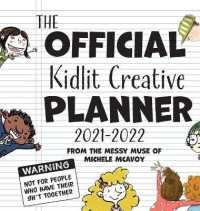Full Description
Elizabeth Bennet is Austen's most liberated and appealing heroine, and Pride and Prejudice has remained over most of the past two centuries Austen's most popular novel. The story turns on the marriage prospects of the five daughters of Mr. and Mrs. Bennet, and especially on Elizabeth's prejudice against the proud and distant Fitzwilliam Darcy. Pride and Prejudice is a romantic comedy that has been read as conservative and feminist, reactionary and revolutionary, rooted in the time of its composition and deliberately timeless. Robert Irvine's introduction sets the novel in the context of the literary and intellectual history of the period, dealing with such crucial background issues as class relations in Britain, female exclusion from property and power, and the impact of the French Revolution.
The introduction and annotations have been expanded and updated for the new edition, and a new appendix of Austen's juvenilia has been added.
Contents
Acknowledgements
Introduction
Jane Austen and Her Time: A Brief Chronology
A Note on the Text
Map
Pride and Prejudice
Appendix A: From the Juvenilia (1792-93)
1. From Volume the First: "The Three Sisters"
2. From Volume the Second: "From a young Lady in distress'd Circumstances to her freind"
Appendix B: From Austen's Letters to Her Sister Cassandra
1. To Cassandra Austen, 8-9 January 1799
2. To Cassandra Austen, 11 June 1799
3. To Cassandra Austen, 29 January 1813
4. To Cassandra Austen, 4 February 1813
Appendix C: Contemporary Periodical Reviews of Pride and Prejudice
1. British Critic (February 1813)
2. From Critical Review (March 1813)
Appendix D: From the Conduct Books
1. From James Fordyce, Sermons to Young Women (1766)
2. From Dr. John Gregory, A Father's Legacy to His Daughters (1774)
Appendix E: Domestic Tourism
1. From William Watts, The Seats of the Nobility and Gentry (1779)
2. From William Bray, Sketch of a Tour into Derbyshire and Yorkshire (1777)
Appendix F: Burke on the French Revolution
1. From Edmund Burke, Reflections on the Revolution in France (1790)
Appendix G: Discussion of Women's Role after the French Revolution
1. From Mary Wollstonecraft, A Vindication of the Rights of Woman
2. From Hannah More, Strictures on the Modern System of Female Education (1799)
Appendix H: The Militia Regiments on the South Coast of England in 1793-95
1. Women at the Brighton Camp, from The Sussex Weekly Advertiser (1793, 1795)
2. The Mutiny of the Oxfordshire Militia, from The Sussex Weekly Advertiser (1795)
Works Cited and Select Bibliography








